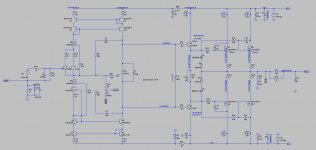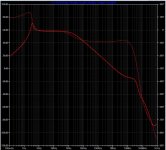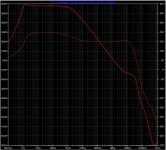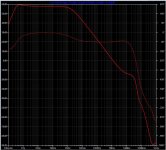I am now designing a simple CFA mosfet amplifier that needs a DC servo.
The servo action is injected in the NFB node.
With the servo output unfiltered I am noticing a spike near 3.5Hz in the OLG plot. This spike is accompanied by a phase inversion.
Filtering the output of the servo with an RC (R19 20k and C6 47u) I can greatly reduce the spike and reduce it's frequency (now small peak @ 1.4hz) and phase is not severely inverted.
Increasing the value of this capacitor gives even better results (As an example see the plot with C6 1000uF).
My question is:
Does the RC filter in the output of the servo reduce it's speed ?
How high can I go with the filtering capacitor ?
Is there a drawback in using such servo ?
1st image - Amplifier circuit
2nd image - Servo circuit
3rd image - OLG plot without filtered servo
4th image - OLG plot with 47u filter
5th image - OLG plot with 1000u filter
The servo action is injected in the NFB node.
With the servo output unfiltered I am noticing a spike near 3.5Hz in the OLG plot. This spike is accompanied by a phase inversion.
Filtering the output of the servo with an RC (R19 20k and C6 47u) I can greatly reduce the spike and reduce it's frequency (now small peak @ 1.4hz) and phase is not severely inverted.
Increasing the value of this capacitor gives even better results (As an example see the plot with C6 1000uF).
My question is:
Does the RC filter in the output of the servo reduce it's speed ?
How high can I go with the filtering capacitor ?
Is there a drawback in using such servo ?
1st image - Amplifier circuit
2nd image - Servo circuit
3rd image - OLG plot without filtered servo
4th image - OLG plot with 47u filter
5th image - OLG plot with 1000u filter
Attachments
Did you connect GNDI with actual GND somewhere? I mean connect with wire, not 10 Ohm resistor. If not, GNDI is kind of bootstrapped by the output. That may cause the spike you see.
If I connect C6 to GND instead of to GNDI the spike is much much worse.
I am using R18 10ohm as input gnd lift - a very effective trick to avoid hum in my builds.
But my most important doubt is... how large can I go with the servo C6 cap ?
I am using R18 10ohm as input gnd lift - a very effective trick to avoid hum in my builds.
But my most important doubt is... how large can I go with the servo C6 cap ?
You will not get hum in the simulation.
You have to short between GNDI and GND with wire in the simulation.
PS: even with lifted ground, the DC impedance between GNDI and GND is Zero in the real world. You break ground loop, even it is not a loop any more, they are still connected with each other, imagine it.
You have to short between GNDI and GND with wire in the simulation.
PS: even with lifted ground, the DC impedance between GNDI and GND is Zero in the real world. You break ground loop, even it is not a loop any more, they are still connected with each other, imagine it.
Last edited:
I understand now. You are talking about the sim results only. Anyway I must filter the servo output otherwise olg is very low in the first octave.
From my experience there are nothing but benefits in using this arrangement. Larger caps will go lower but once you get a couple of decades below 20 Hz there's not much point pushing your luck. I've had best results with FET op-amps (the ubiquitous TL071) as other types sometimes fail to lock the loop. The LF411 would thus appear to be a good choice.
I suggest you simulate the loop gain of the DC servo portion. More than one low pass poles in the system, you have to make sure you are not making a “phase shift oscillator”. Check the phase margin and gain margin of the DC servo.
Thank you guys.
I will analyse the servo loop.
This circuit works without the rc filter on the servo output. I have built severall amps with this servo but I was not sure about the capacitor value.
Please see my work here: RCP130 modular lateral mosfet power amplifier
I will analyse the servo loop.
This circuit works without the rc filter on the servo output. I have built severall amps with this servo but I was not sure about the capacitor value.
Please see my work here: RCP130 modular lateral mosfet power amplifier
- Home
- Amplifiers
- Solid State
- DC servo with RC filter question




